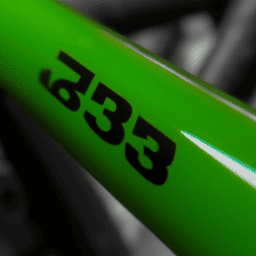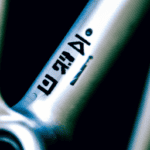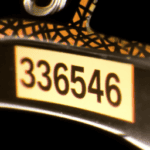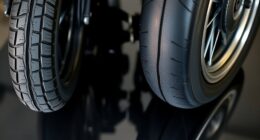You’re set to sign up your new bike, but finding the serial number is giving you trouble. Fear not, this is a frequent oversight. This crucial detail is often missed, yet it’s essential to keep it accessible for several purposes, including recovering your bike if it’s stolen, filing for warranty services, and preserving its resale value.
In this article, we’ll guide you through the process of finding the serial number on your bicycle, step-by-step. Whether you’re a seasoned cyclist or new to the sport, it’s easy to miss the serial number’s location on your bike. It’s not always in plain sight, and different manufacturers can place it in various locations.
However, it’s essential to know where it is, as the serial number is a unique identifier that distinguishes your bike from others and can help authorities track it down if it’s stolen. So, let’s dive in and explore the different areas on your bike where you can find the serial number.
Key Takeaways
- Serial number is a unique identifier that is crucial for theft recovery, warranty claims, and resale value of a bicycle.
- Serial number can be located on the bottom bracket, head tube, rear stays, or seat tube.
- Recording the serial number in a safe place is important as it increases the chances of recovery and prosecution of the thief and can be helpful in case of reporting a stolen bike or filing an insurance claim.
- Serial number may be required for warranty claims, police reports in case of theft, resale of the bike, shipping the bike, repairs or replacement parts.
Check the Bottom Bracket
You’ll find the serial number on your bike by getting down low and checking the bottom bracket. This is the part of the frame where the pedals attach.
Look for a series of letters and numbers stamped or engraved onto the metal surface. The serial number may be located on the left or right side of the bottom bracket, depending on the bike manufacturer.
It’s important to note that measuring accuracy is crucial when reading the serial number. A common mistake is misreading a letter or number, which can lead to confusion when identifying the bike. Take your time when looking for the serial number and double-check it against any documentation you have for your bike.
If you’re having trouble finding the serial number on the bottom bracket, don’t worry, there are other locations you can check. For instance, you can look at the head tube.
Look at the Head Tube
Check out the head tube for a quick way to identify your bike’s model. The head tube is the part of the frame that connects the top and bottom tubes of the bike’s front end. It’s a great spot to look for identifying numbers because it’s easily visible and accessible.
Here are some things to keep in mind when exploring the head tube as a serial number location on bicycles:
-
Measuring accuracy: When trying to identify your bike’s serial number on the head tube, use a ruler or measuring tape to ensure that you’re measuring accurately. Serial numbers can be small, and a millimeter off could mean the difference between identifying your bike and not.
-
Identifying variations: Some bike manufacturers place the serial number on the side of the head tube, while others place it on the bottom. Be sure to check all sides of the head tube to identify any variations in location.
-
Historical context, legal requirements: Serial numbers on bicycles found on head tubes are significant because they help identify the bike’s model, year, and manufacturer. They’re also important for legal purposes, such as theft recovery and insurance claims. Understanding the historical context and legal requirements surrounding serial numbers can help you better appreciate their significance.
Understanding the significance of serial numbers on bicycles can make all the difference when it comes to identifying your bike’s model and year. Now that you’ve explored the head tube as a potential location for your bike’s serial number, let’s move on to another possible location: check the rear stays.
Check the Rear Stays
Now let’s take a look at the rear stays of the bicycle. The rear stays are the frame tubes that connect the rear wheel hub to the main frame of the bicycle.
To locate them, look for the two tubes that run from the axle of the rear wheel up to the seat tube. The rear stays are an important part of the bicycle frame as they provide stability and support.
Additionally, the serial number is often located on the inside of the non-drive side rear stay near the dropout. This location is chosen because it’s easily accessible, yet hidden from view, making it difficult for thieves to remove or tamper with.
What are Rear Stays
If you’re familiar with the anatomy of a bicycle, you’ll know that the rear stays are the two diagonal tubes that connect the rear wheel to the frame. The rear stays play an important role in the functionality of the bike, as they help to maintain the proper balance and stability of the bicycle. There are two types of rear stays: chain stays and seat stays. Chain stays connect the rear wheel to the bottom bracket of the frame, while seat stays connect the rear wheel to the top of the seat tube.
To better visualize the function of the rear stays, take a look at the table below:
| Rear Stay Type | Function |
|---|---|
| Chain stays | Help transfer power from the pedals to the rear wheel |
| Seat stays | Help absorb shock from the road |
Understanding the function of the different types of rear stays can help you better appreciate the design and engineering that goes into building a bicycle. Now that you have a better understanding of what rear stays are and what they do, let’s move on to how to locate them on your bicycle.
How to Locate the Rear Stays
Locating the rear stays is essential in understanding how your bike maintains its balance and stability while transferring power from the pedals to the rear wheel and absorbing shocks from the road. To locate the rear stays, follow these steps:
- Look for the chainstays, which are the two tubes that run parallel to the chain.
- Find the seat stays, which are the two tubes that connect the top of the seat tube to the rear dropouts.
- Measure the distance between the rear dropouts to ensure measuring accuracy.
- Use a ruler or a tape measure to measure the length of the seat stays and the chainstays.
Common mistakes when locating the rear stays include confusing them with the fork or the front triangle. To avoid these mistakes, make sure to look at the back of the bike and focus on the area behind the seat tube.
Using the right tools and following these tips for success will help you locate the rear stays with ease.
Knowing how to locate the rear stays is crucial because it is where the serial number is usually located. The serial number is essential for registering your bike, reporting it if stolen, and identifying its make and model.
In the next section, we’ll discuss why the serial number is located on the rear stays and what to do if you can’t find it.
Why the Serial Number is Located Here
The placement of the production code on the posterior portion of the frame provides a permanent record of the bike’s manufacturing details. This code, also known as the serial number, is crucial for bike registration and identification. It contains information about the manufacturer, model, and year of the bike.
In case of theft or loss, the serial number helps authorities and bike owners identify and recover the bike. That’s why it’s essential to register your bike and keep track of its serial number. Bike theft is a common problem, and having a registered bike with a visible serial number increases the chances of recovery and prosecution of the thief.
You can also prevent bike theft by locking your bike correctly and in a visible location, using a high-quality lock, and avoiding leaving it unattended for long periods. Now, let’s look at the seat tube to find another important detail about your bike.
Look at the Seat Tube
Check out the seat tube to find the serial number on a bike, it’s usually stamped on there. The seat tube is the part of the frame that the seat post fits into. It’s important to note that the serial number is not always located in the same spot on the seat tube. It could be on the top, bottom, or side of the tube.
Here are some tips to help you locate the serial number on the seat tube:
- Look for a series of numbers and/or letters that are stamped or engraved onto the metal.
- Check for any additional markings or symbols that may be present near the serial number.
- Use a flashlight or magnifying glass to get a closer look, as the serial number may be small or difficult to read.
Once you have located the serial number on the seat tube, be sure to write it down and keep it in a safe place. If you ever need to report a stolen bike or file an insurance claim, having the serial number on hand can be extremely helpful.
If you’re having trouble finding the serial number on the seat tube, don’t worry! There are other places to look, such as the owner’s manual or original receipt.
Check the Owner’s Manual or Original Receipt
If you didn’t find the serial number on the seat tube, don’t worry. There are still other ways to locate it. One possible option is to check the bike’s owner’s manual or original receipt. These documents usually contain important information about the bike, including its serial number.
To find the serial number, look for a section in the manual that provides details about the bike’s specifications or equipment. The serial number is typically listed alongside other identifying information such as the model number and date of purchase. If you don’t have the manual, try looking for the original receipt. The serial number may be printed on the receipt or listed in the bike’s description. If you can’t find either of these documents, don’t worry. There are still other ways to locate the serial number, such as contacting the manufacturer or seeking help from online forums.
| Method | Pros | Cons |
|---|---|---|
| Check Owner’s Manual | Easy to access | May not have manual |
| Check Original Receipt | Easy to access | May not have receipt |
| Contact Manufacturer | Direct source of information | May take time to receive response |
| Seek Help from Online Forums | Free resource | Information may not be accurate |
By exploring these different options, you should be able to locate the serial number of your bike. Remember, the serial number is an important piece of information that can help you identify your bike in case of theft or loss. Make sure to record it in a safe place and keep it on hand in case you need it in the future.
Frequently Asked Questions
How do I identify the brand of my bike?
To identify your bike’s brand, start by identifying the bicycle frame. Look for logos or brand names on the frame, fork, or seat post. Researching bike components can also help narrow down the brand.
Can I find the serial number on any other part of the bike besides the ones listed?
Alternative identification methods include checking the bike’s frame for any identifying marks or stickers. However, the serial number is the most reliable method. Registering your bike with local authorities is crucial for recovery if stolen.
What is the purpose of a bike’s serial number?
The purpose of a bike’s serial number is to aid in checking ownership and reporting theft. It serves as a unique identifier and can be registered with the manufacturer or a third-party database for added security.
Is it possible for a bike to not have a serial number?
Coincidentally, some bikes don’t have serial numbers, but this presents issues. Without a serial number, it’s nearly impossible to report a stolen bike. Also, if the bike is involved in an accident, the legal implications of missing serial numbers may arise.
How can I prevent my bike from getting stolen based on its serial number?
To prevent bike theft based on its serial number, register your bike with your local law enforcement agency or a bike registration service. If your bike is stolen, report it immediately with the serial number to increase the chances of recovery.
Conclusion
Congratulations! You now know where to find the serial number on a bicycle. By following the steps outlined in this article, you can easily locate the serial number on your bike.
Whether it’s on the bottom bracket, head tube, rear stays, or seat tube, you can rest assured that you’ve found the unique identifier for your bike. Imagine the feeling of satisfaction you’ll have when you can confidently provide the serial number to law enforcement, insurance companies, or bike shops.
No longer will you have to worry about bike theft or loss, as you’ll have the security of knowing that your bike can be identified. So go ahead, grab your bike and start searching for that serial number. You’ll be glad you did!
















